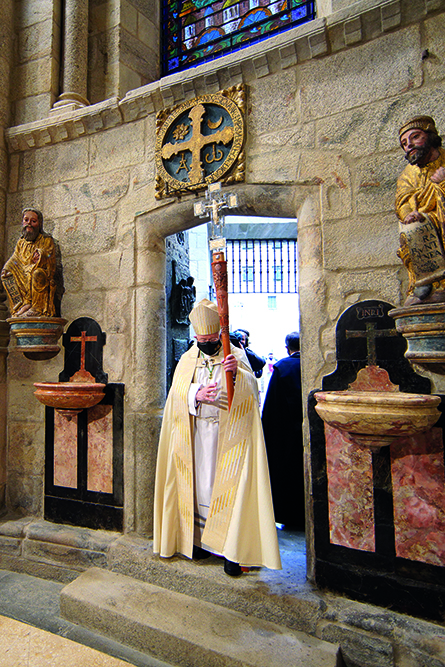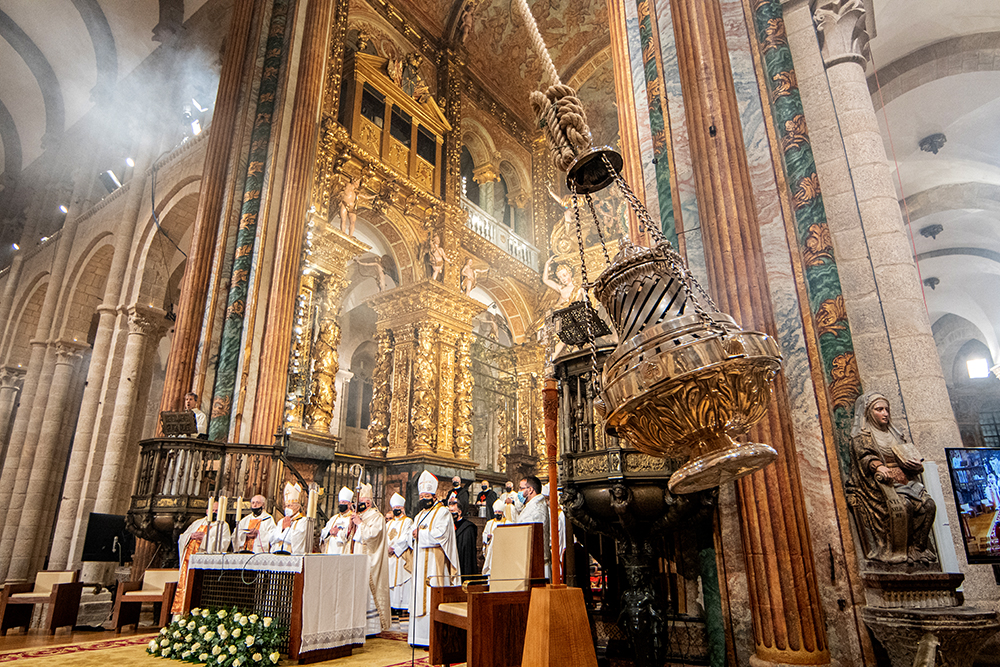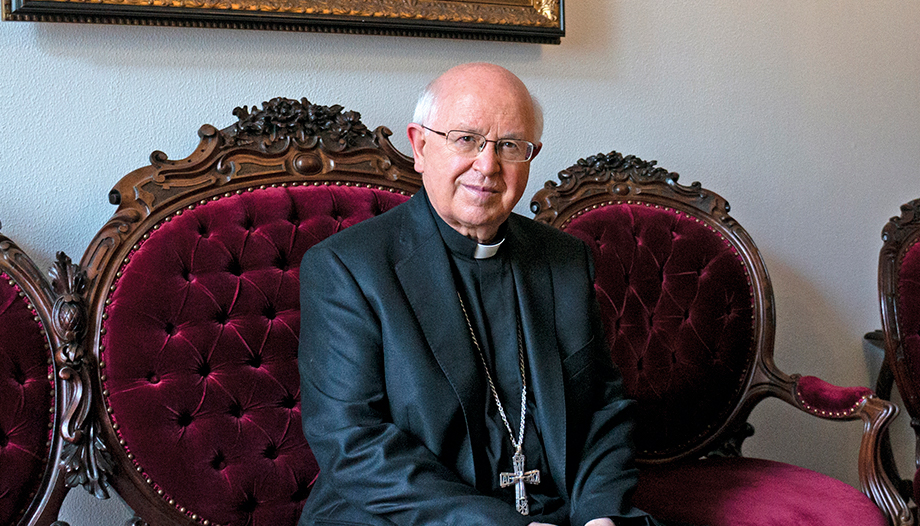Julián Barrio Barrio has been archbishop of Santiago de Compostela since 1996; he had previously been auxiliary bishop. Born in Zamorano, he has since dedicated his efforts and affectionate attention to Santiago. In conversation with Omnes he reviews the current Jubilee. He highlights the spiritual graces that await the pilgrim in Compostela, the new splendor of the cathedral after the restoration and takes stock of his time as pastor of the Galician archdiocese.
The impression conveyed by Fr. Julián Barrio is one of affection, even though he is reserved. On this occasion he openly expresses his joy at the prospects of the Holy Year 2021-2022, in the last phase of his responsibility as archbishop, and naturally at the possibility of a visit of the Holy Father to Santiago during this Jubilee.
It seems that the number of pilgrims to Santiago will recover during the Jubilee Year. What are the archdiocese's expectations?
-Certainly, after the end of the state of alarm, and with the advance of the vaccination campaign, it is foreseeable that there will be an increase in the number of pilgrims. So far, so far this year, the numbers are much lower, not only than in previous Jubilee Years, but also than in normal years, when the presence of pilgrims was already noticeable in the spring. In any case, we are aware that this situation is also challenging us diocesans, so that we know how to get involved in this inner pilgrimage of conversion of heart, which will make it easier for us to welcome pilgrims, especially later this summer and in the year 2022.
The Camino de Santiago is a cultural heritage and a growing reality. Other places have even discovered the "camino" phenomenon, and have promoted their own "caminos". What's in this "walking"?
-Above all, it is a spiritual reality. Without this dimension of faith, of outward manifestation of the desire to meet Christ through the pilgrimage to the tomb of the Apostle St. James, the Camino would be an inert reality.
In the Pastoral Letter in which he convoked the Holy Year, "Go forth from your land: the Apostle St. James awaits you", he indicated that our western culture cannot throw overboard its religious tradition like an outdated bundle. It is true that this tradition has by no means a monopoly on values. However, it strengthens them with an unconditional foundation, beyond cultural circumstances and political agreements.
Our societies need, together with their own institutions, a sap that conveys these values to our citizens, legitimizes them with deep and transcendent roots, and promotes them as unconditional beyond our fragile consensuses. The Way of St. James is a search and an encounter.
"Arriving at the tomb of St. James is not only the result of a remarkable physical effort, but of the desire to meet with oneself, with others and with God".
Bishop Julián Barrio. Archbishop of Santiago de Compostela.
In this Jubilee Year after the pandemic, what can Santiago offer pilgrims who set out for a reason of faith?
-Above all, the Jubilee graces, the immense gift of what has come to be called the "great forgiveness. The gift of forgiveness and mercy awaits us in the House of St. James, who presents us with the Savior, the Risen Christ.
Arriving at the tomb of St. James is not only the result of a remarkable physical effort, but of the desire to meet oneself, others and God. For the Christian, faith is light for freedom. It is not a shortcut, nor does it prevent us from being the ones who have to walk. But yes, faith impels us to the most risky adventure of life: to make it bear fruit where we are and in the circumstances we have. It is like the antidote to false human securities: we entrust ourselves into the hands of the One who can do all things.

For other pilgrims who move for non-religious "spiritual" reasons, or who lack a specific motivation, what can the experience of the Camino and the Jubilee mean?
-That is precisely it: to show that close face, human by divine, of the Church, which since the Middle Ages through the hospitals of the Camino, through its shelters and temples, has created an environment of ecological protection for man, for the human person in whatever state he may be in.
If the Way of St. James welcomes all those who sense the voice of God, even if they are often unaware of it, as I have said on another occasion, after the painful experience of the pandemic, this Way of conversion is open to all - "God makes no distinction of persons"-, it has no restrictions or perimetral closures, nor does it have a numerus clausus. On the contrary, one of its permanent values is that it offers the possibility for pilgrims to come into contact with God, even for those who have not yet discovered the Christian faith. This has a special value in our times when many people still feel the Church is far away.
Pastoral care on the Camino continues to be a challenge for the dioceses. What do you find lacking in the care given to walkers, to facilitate their encounter with God?
-In this regard, I must say that a great effort has been made in recent years. The implementation along the pilgrimage route of the Christian welcome program along the way is a milestone. The difference is remarkable and the pilgrims with whom I have the opportunity to speak when they arrive in Santiago let me know it. Here, at the end of the Camino, we have had the opportunity to meet several times.
More and more people are volunteering to welcome and accompany pilgrims. Many of the young people who belong to our Delegation of Children and Youth do accompaniment every summer: they invite the pilgrims to pray, to sing, to share, to experience the evening Eucharist.
But everything can be improved, especially the need to have as many temples, hermitages and churches open along the Camino as possible. Pilgrims have also told me that many times they do not find a place open where they can rest from their day-to-day experience.
This year the arrival in Santiago has an extraordinary "prize": to see the restored Portico de la Gloria.
-Effectively. And not only that, but you can contemplate the restoration of the Cathedral, a work that has required years of study, dedication and effort on the part of the many parties involved in this task.
The day the Cathedral was "reopened," I had the opportunity to say that we were before a true splendor of human beauty that refers us to divine beauty. "Contemplating the Portico of Glory and seeing the High Altar," I said, "crowned by so many angels that the restoration has made it easier for us to see, I can say: 'Behold the dwelling of God among men,' in this City of the Apostle, once called the Jerusalem of the West." And, truly, I have been able to verify that for those who contemplate our Cathedral, the recurring question is where so much beauty has come from, referring to so much effort, so much precision, so many details. The recovery of the polychromy of the Portico gives us a clue as to how the work of Master Mateo must have functioned catechetically in his time.

Is the restoration of the rest of the cathedral completed?
-No. The work is not completely finished. We are still working on different aspects, on some of the roofs, on the cloister. There are still months to go before it is finished. And I would like to express my gratitude to all those who have worked to make all this a reality: to the local, regional and state administrations, as well as to private entities that bet on this authentic rejuvenation of our mother church.
Everything in the cathedral speaks to the visitor as a catechesis. For this year, have you put in place means to bring visitors closer to the teaching it contains?
-We have prepared guides for the pilgrimage, so that the groups that approach Santiago can make a serene, leisurely reflection at each stage of their journey in faith to the tomb of the Apostle.
In addition to the spiritual dimension, there is also a cultural and artistic dimension. We have launched a specific web page for the Holy Year (https://anosantocompostelano.org/), which includes testimonies of pilgrims and links to the Cathedral's web page, where you can find written and graphic documents about the patrimonial value of our great temple, which continues to be the Pilgrims' House above all, above any museum consideration.
"Whoever contemplates our Cathedral, now restored, wonders where so much beauty, so much precision, so many details could have come from."
Bishop Julián Barrio. Archbishop of Santiago de Compostela
The extension of this Jubilee to two years (2021-2022) is exceptional. It is likely to be a special opportunity at precisely this time:
-It is a gift from Pope Francis. It is not really two holy years, but an extended Holy Year. It is a real opportunity for us to go out of ourselves, to start walking, to reflect on our personal and community situation. The pandemic seems to have disrupted everything, to have affected our security, to have limited our expectations. But perhaps this is the best time to read in the key of faith the harsh reality that we have had to live through. A believing reading of this evidence should lead us to live with full confidence in God, in his providence and in hope. Attentive to the signs of the times, the coronavirus, the deaths, the pain of the victims, the social, health and economic crisis, we Christians must offer what we have: time, welcome, availability and concrete gestures of solidarity and charity with those most in need.
In the archdiocese of Santiago, not everything is the Camino. What other aspects stand out today among the interests of your archbishop?
-I have been saying for some time now, especially after our recent Diocesan Synod, that our diocesan Church - and I believe that in general the whole Church - must continue to advance in the awareness of the identity and mission of the laity, recognizing the indispensable contribution of women. I accompany and feel accompanied by the young people, who are also doing their particular Synod, because I see that it is not easy for them to find answers to their problems and wounds, including their professional future. In a special way, they must wear the sandals of hope.
On the other hand, it is clear to no one that a special concern is the high age of our priests and the shortage of vocations. That is why we need fathers and mothers who will open their children's eyes to spiritual intelligence, a training that will later make it possible for them to accept the gift of faith in God incarnate in Jesus Christ.
You arrived here some years ago, in 1993, and this year you will celebrate your 75th birthday. What do you appreciate most in the Archdiocese of Santiago?
-I would not be the person I am without these long years in the land of St. James the Apostle. My work as a pastor has developed among the people of Galicia, who have taught me to love God with the humility and simplicity that they themselves practice. The strong faith that the Galicians have been able to transmit from generation to generation is a value of incalculable merit. I have lived through hard times with them, such as the Alvia accident or the tragedies at sea and I have appreciated the human quality of all of them, their availability, their strength. I have learned a lot from the priests, from their dedication, their devotion and the good work of the Consecrated Life.
You are from Zamora, but there is no doubt that you feel at home here. Thinking back over the years, could you tell us the most valuable thing you have learned in Santiago?
-I have said it on occasion: Galicia enters the lives of those of us who are not Galicians by birth with delicacy, with sentidiño, with that warmth of the lareira in which the fruits of autumn are cared for. They welcomed me with great affection: not because of my merit but because of their benevolence and the generosity of this land where "everything is spontaneous in nature and where the hand of man gives way to the hand of God", as Rosalía de Castro wrote. And what can I say about Santiago: I would like to say, with the expression of Isaiah, that "I have him tattooed on the palm of my hand". It has been my life as a bishop, it has been my task, it has been my dedication.
Allow me to ask you a question "going forward", based on these years of dedication to this archdiocese, on what basis do you think we should continue to work?
-Certainly it will no longer be up to me to make this decision in the years to come, since, as you well know, this August 15, when I reach the established age, I will present my resignation to the Holy Father. I do not know when he will accept it. I am in God's hands. As I have been since that awakening of my priestly vocation by the priest of my town, Manganeses de la Polvorosa. In any case, as I said before, the recent Diocesan Synod was born and closed with a vocation of service for the future.
"Our great temple continues to be the Pilgrims' House above all, over and above
Bishop Julián Barrio. Archbishop of Santiago de Compostela
any museum consideration".
Both St. John Paul II and Benedict XVI were in Santiago. Pope Francis has been invited to come during the Jubilee Year, and the same has been done in Avila and Manresa for celebrations of St. Teresa and St. Ignatius. Do you have any more information?
-Nothing would please me more than for the Holy Father to come to Compostela as a pilgrim. I hope we can have the grace of Pope Francis' visit. He is invited. And not only on the part of the Church... It would be a wonderful gift to have his presence and for me, after having had the satisfaction of receiving Benedict XVI, it would be another of those moments to thank the Lord in my life as a bishop.
You had the opportunity to meet Pope Francis himself in June, accompanied by the president of the autonomous government of Galicia. Do you think his visit is closer after this special audience and his invitation?
--I believe that if the circumstances are favorable and there is no problem, the Holy Father could come to Santiago. In case he comes, the one who has to announce it is he himself.
The pandemic is a conditioning factor, that's key. But I am optimistic. If the vaccination process goes as it is going so far, I hope that by the end of the year we will have immunized a large part of the population, and that would contribute to favor the possible visit, towards the summer of next year.








